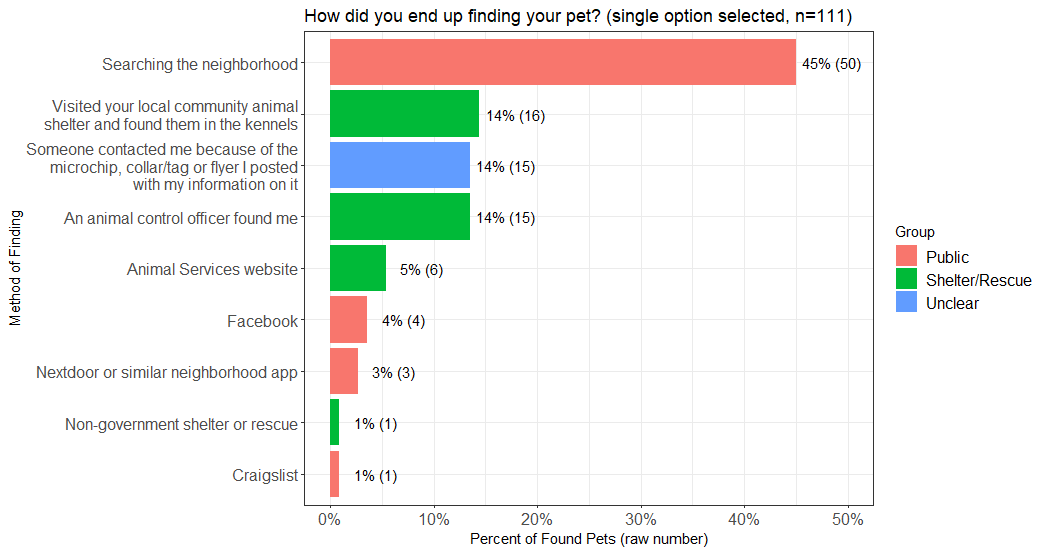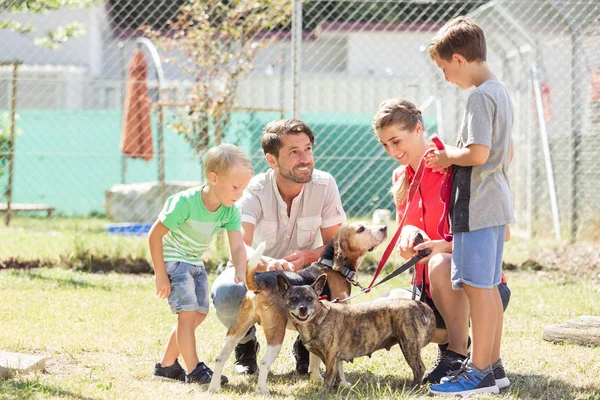Traditionally, a return-to-home (RTH) takes place when a family arrives at the shelter to be reunited with a lost companion, or whenever animal services have made it a priority for field officers to take pets home vs. bring them straight to the shelter.
There is another way shelters can facilitate RTH, which HASS data indicates is likely to be even more effective—working with finders of lost pets in the community and avoiding shelter custody altogether. Where this has been tested in HASS pilot communities, we are seeing that RTH through a new approach sometimes surpasses shelter RTH rates.
Past research in animal welfare, multiple new HASS surveys, and a HASS pilot program show that many people already naturally engage in reunifying lost pets with their families completely on their own and that more would be willing if only they are asked and supported. Setting up a way for people to report lost and found pets, supporting and guiding finders, and tracking report outcomes are easy ways to start a “Public RTH” effort without creating much extra work for staff. In the rest of this brief we’ll take a deeper dive into the motivation for engaging the public in RTH efforts, the data-informed evidence of its efficacy, and practical ways to start.
How are lost pets recovered?
Doubling down on lost pet reunification makes sense because loose or lost animals are the largest intake group across shelters (according to Shelter Animals Count Q1-Q2 2023 reports, as well as our own HASS pilot shelters’ data). Additionally, past research on lost pets suggests that many are already assisted in finding their way home without the shelter involved. Excluding animals who came back on their own, both dogs and cats were most often reunited with their families through finders physically searching the area, and inquiring with neighbors (Huang et. al, 2018, Weiss & Lord, 2012). While there are no studies of newer community-based platforms such as Facebook or NextDoor groups, which have grown in popularity in recent years, many communities use these or equivalent platforms when pets go missing, and shelters are already collaborating with active members in these groups.
In an attempt to collect more up-to-date data on how pets get back home outside shelter RTH, questions about this subject were included in a survey that was deployed in nine HASS communities. This Community Values Survey was primarily aimed at understanding communities’ opinions about pets and the role of shelters, but respondents were also asked if they lost a pet in the last three years. If so, and if it was found, they were asked how long it took and how they were reunited. A total of 2,540 responses were collected across all nine locations via an external surveying agency, obtaining a representative sample of their populations on several demographic features.
Out of 2,540 survey respondents, 1,953 either had a pet at the time of survey or in the previous three years. Of these, 461 people (23.5% of pet owners) reported their pet went missing at some point during the last three years, and 309 of them (67%) were reunited with their pets. Dogs were found slightly more often than cats (70% vs 62%). Ninety-two pets (30%) came back on their own. Ten options were offered in the survey as ways of being found, with multiple selections accepted. Since some selections may reflect ways that were only attempted alongside others, results here focus on those with a single return reason (111 animals).

In the survey results, 53% (58) of these pets were returned home by either searching the neighborhood (50) or using a social media platform (8), while 38% (34) came back through a contact with the local animal services (animal control, the shelter’s website, or a physical visit to the shelter). These results are in line with previous studies, showing that shelters may be wise to tap into the existing efforts of people to get lost pets home.
People want to be involved
Beyond these signs of existing public participation, surveys developed by HASS to collect up-to-date evidence show that more people are willing to help with reunification efforts when asked. In the survey of nine HASS communities, 510 respondents reported taking a pet they found to their local shelter. Of these, 88% said they would have agreed to hold onto it while they searched for its owner if they had been asked by the shelter to do so and offered support and guidance; and 51% said they would do it for more than a week if needed. This makes sense—people who already took the initiative to let the shelter know about a lost pet are likely to take an extra step and help get it home.
In another survey performed in six HASS pilot shelters, finders who had already arrived at the shelter with a lost pet were asked to hold onto it and help with the reunification process, and 37% agreed to do so. This 37% was also the participation rate in a separate pilot program carried out in six other HASS pilot shelters, asking finders to hold onto pets either when arriving at the shelter or when they submitted found reports online, and providing guidance and resources. The outcomes of this program are discussed later. Even if the true percentage of people who would help if asked is not the 88% who stated they would do it in the larger survey of nine communities, it is presumably higher than the 37% who agreed to do so despite already coming all the way to the shelter to bring in a pet they found.
These data should motivate shelters to ask community members to help with RTH efforts. But what should they do, exactly, and will they actually be effective in getting these pets home?
Does it work?
In most shelters where we have comprehensive data, the RTH rate of pets found and held by the public (reported via a found report) was higher than the RTH rate from the shelter. At one HASS pilot organization, a non-profit with a government contract for county animal services, lost and found reports have been in place for several years, with staff and volunteers performing follow-up with finders as well as offering support and additional resources. Analyzing their 2021 data compared to their shelter outcomes, we found that out of 606 found reports, 161 (26%) pets have been reunified with their families by their finders, and an additional 128 (21%) were kept or rehomed by finders after a designated period of time passed. This is compared to a 10% RTH rate for strays taken into the shelter. Only 10% of reports had an unknown outcome. In a larger, high-volume government shelter, which has been working with lost and found reports for many years, the RTH rate from reports was similar to the shelter’s RTH rate consistently between 2019 and 2022. Report volume ranged from 1,000-2,000 annually, with a dedicated staff member responsible for follow-up.
Another source of evidence for effectiveness in RTH when involving the public came from a program implemented at six HASS pilot shelters from spring to summer of 2022, mentioned above. The essence of the program was straightforward—finders of friendly and healthy lost pets were asked to hold onto them for 48 hours. A report was created to be shared on the shelter’s website and with community groups, while the finder was given guidance on other actions they could take to promote reunification (and rehoming, if an owner was not found), and they were followed up with to document the outcome or coordinate intake if needed.
Among the 37% of people who agreed to hold onto a lost animal, 30% of the animals they helped had good outcomes. These outcomes were split evenly between a reunification outcome or another positive outcome that kept them out of the shelter (finder rehomed or kept the animal after a period of time equivalent to a stray hold). This RTH rate was double the RTH rate of animals arriving over-the-counter to the shelter during the time of the program and taken into custody.
In looking outside shelters’ data, in the 9-community survey conducted by HASS, we see similar results. When asking community members directly whether they had ever found loose/roaming pets and what they did with them, we found that 30-40% of the pets were returned home by the finder, with an additional 10-20% kept by the finder and 10% rehomed (with the ranges due to variations between communities).
These numbers suggest that people, through their community connections and tools, can be very effective at reuniting pets with owners. The remaining question is how to set this process up without overburdening staff. This is a legitimate concern because, for some HASS pilot shelters, setting up the system to start collecting reports and following up with finders was difficult amidst all their existing work.This is to say, it does take some initial short-term effort to launch finder-supported programs, but the benefit would be long-lasting.
First steps with Public RTH
From our experience working with shelters in this process, the simplest way to start was providing an easy way for people to report lost and found pets, ensuring profiles of all found pets are uploaded to a place where their owners could see them, and supporting finders holding onto pets with a detailed checklist featuring steps towards an RTH outcome—along with the reassurance that they were not on their own and the shelter would step in if needed to intake the lost pet.
One key step is data collection. After running lost and found reports for some time, it will be beneficial for shelters to be able to check how many people are participating relative to their stray intake, the outcomes of the pets they found, and how many of them are kept out of the shelter yet still have a positive outcome. All major shelter software systems have modules that allow tracking of found reports, and after an initial set-up effort, they are fairly easy to maintain.
A common challenge is the time required to follow up with finders to find out what happened to reported pets. For this, basic technological tools can help, such as bulk texting systems. These allow finders to respond quickly to texts, which can be shared and viewed in bulk by staff. Others have used email reminders to complement texting. You can see an entire guide on implementing tools like these here.
There can also be other options to track lost and found reports, such as using existing platforms like Petco Love Lost, which gather reports from many local organizations. Ultimately, the specific implementation of this idea can be up to each organization’s circumstances, but all can benefit from some degree of involving their community members in their reunification efforts.








